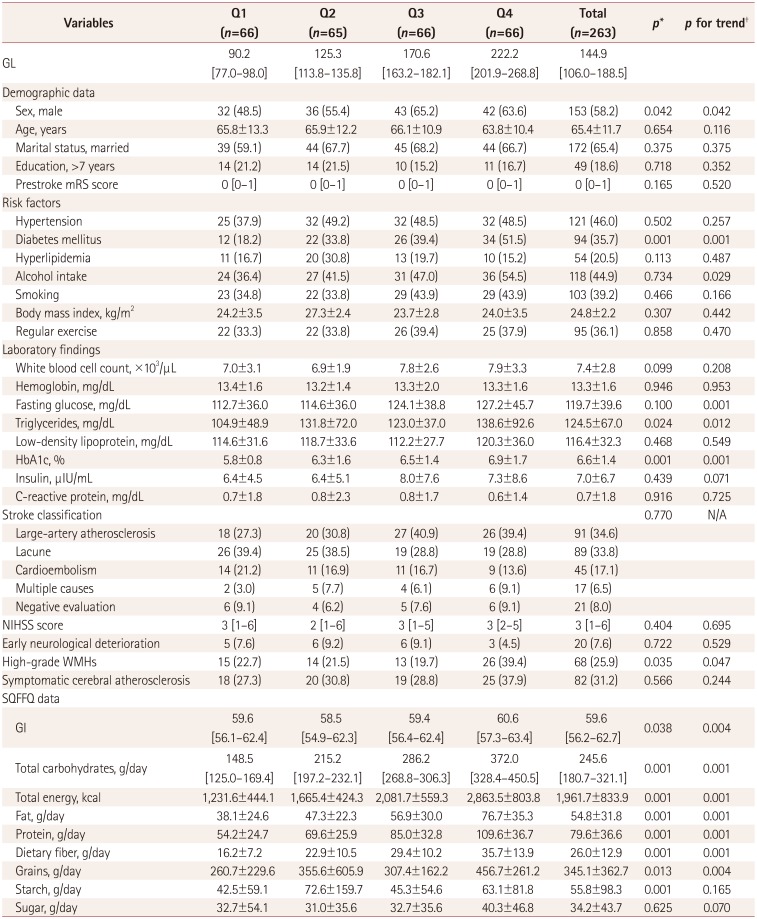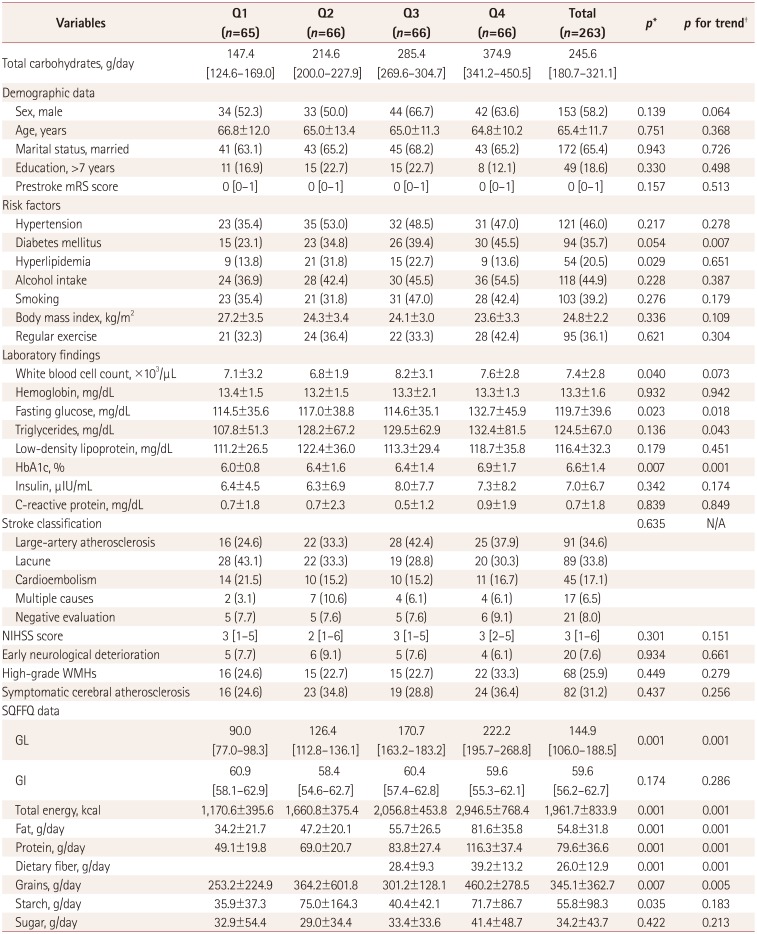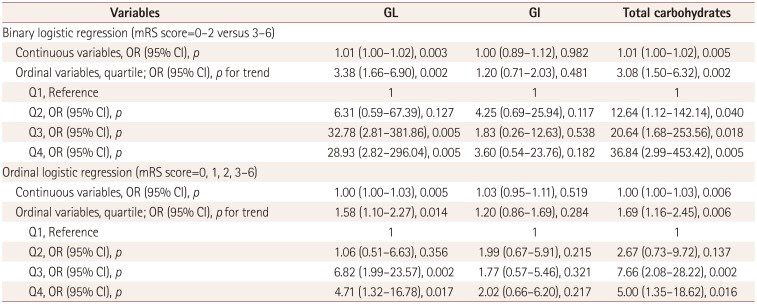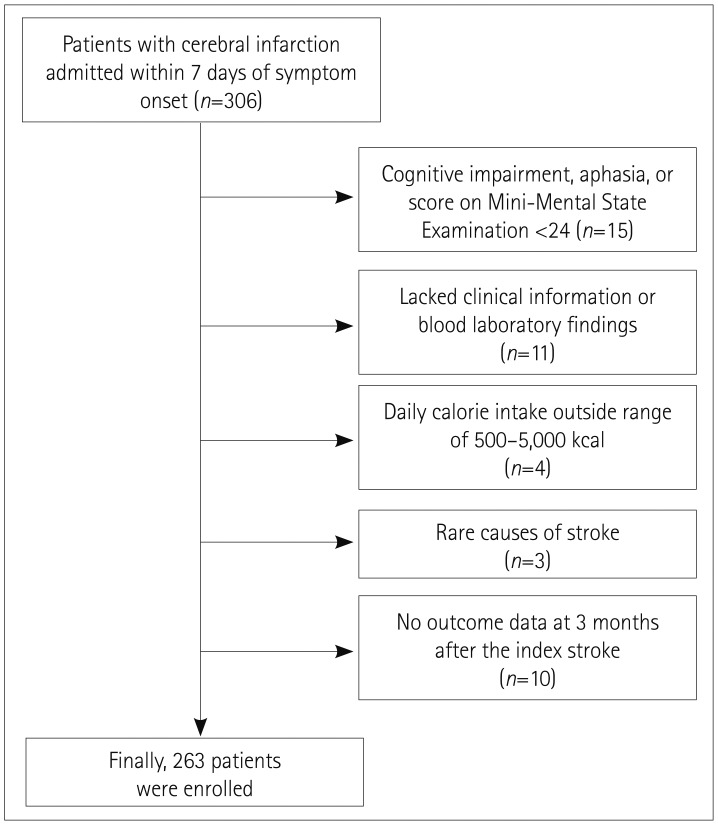1. Levitan EB, Song Y, Ford ES, Liu S. Is nondiabetic hyperglycemia a risk factor for cardiovascular disease? A meta-analysis of prospective studies. Arch Intern Med. 2004; 164:2147–2155. PMID:
15505129.
2. Zhang Z, Yan J, Shi H. Hyperglycemia as a risk factor of ischemic stroke. J Drug Metab Toxicol. 2013; 4:153. PMID:
25328819.

3. Levitan EB, Cook NR, Stampfer MJ, Ridker PM, Rexrode KM, Buring JE, et al. Dietary glycemic index, dietary glycemic load, blood lipids, and C-reactive protein. Metabolism. 2008; 57:437–443. PMID:
18249220.

4. Aston LM. Glycaemic index and metabolic disease risk. Proc Nutr Soc. 2006; 65:125–134. PMID:
16441952.

5. Jenkins DJ, Wolever TM, Taylor RH, Barker H, Fielden H, Baldwin JM, et al. Glycemic index of foods: a physiological basis for carbohydrate exchange. Am J Clin Nutr. 1981; 34:362–366. PMID:
6259925.

6. Oh K, Hu FB, Cho E, Rexrode KM, Stampfer MJ, Manson JE, et al. Carbohydrate intake, glycemic index, glycemic load, and dietary fiber in relation to risk of stroke in women. Am J Epidemiol. 2005; 161:161–169. PMID:
15632266.

7. Levitan EB, Mittleman MA, Håkansson N, Wolk A. Dietary glycemic index, dietary glycemic load, and cardiovascular disease in middleaged and older Swedish men. Am J Clin Nutr. 2007; 85:1521–1526. PMID:
17556687.

8. Oba S, Nagata C, Nakamura K, Fujii K, Kawachi T, Takatsuka N, et al. Dietary glycemic index, glycemic load, and intake of carbohydrate and rice in relation to risk of mortality from stroke and its subtypes in Japanese men and women. Metabolism. 2010; 59:1574–1582. PMID:
20303126.

9. Kaushik S, Wang JJ, Wong TY, Flood V, Barclay A, Brand-Miller J, et al. Glycemic index, retinal vascular caliber, and stroke mortality. Stroke. 2009; 40:206–212. PMID:
18948616.

10. Magalhães R, Abreu P, Correia M, Whiteley W, Silva MC, Sandercock P. Functional status three months after the first ischemic stroke is associated with long-term outcome: data from a community-based cohort. Cerebrovasc Dis. 2014; 38:46–54. PMID:
25226861.

11. Aeberli I, Gerber PA, Hochuli M, Kohler S, Haile SR, Gouni-Berthold I, et al. Low to moderate sugar-sweetened beverage consumption impairs glucose and lipid metabolism and promotes inflammation in healthy young men: a randomized controlled trial. Am J Clin Nutr. 2011; 94:479–485. PMID:
21677052.

12. Luitse MJ, van Seeters T, Horsch AD, Kool HA, Velthuis BK, Kappelle LJ, et al. Admission hyperglycaemia and cerebral perfusion deficits in acute ischaemic stroke. Cerebrovasc Dis. 2013; 35:163–167. PMID:
23429063.

13. Mucci L, Santilli F, Cuccurullo C, Davì G. Cardiovascular risk and dietary sugar intake: is the link so sweet? Intern Emerg Med. 2012; 7:313–322. PMID:
21544534.

14. Adams HP Jr, Bendixen BH, Kappelle LJ, Biller J, Love BB, Gordon DL, et al. Classification of subtype of acute ischemic stroke. Definitions for use in a multicenter clinical trial. TOAST. Trial of Org 10172 in Acute Stroke Treatment. Stroke. 1993; 24:35–41. PMID:
7678184.

15. Song TJ, Kim J, Song D, Nam HS, Kim YD, Lee HS, et al. Association of cerebral microbleeds with mortality in stroke patients having atrial fibrillation. Neurology. 2014; 83:1308–1315. PMID:
25186853.

16. Oh MS, Yu KH, Lee JH, Jung S, Ko IS, Shin JH, et al. Validity and reliability of a Korean version of the National Institutes of Health Stroke Scale. J Clin Neurol. 2012; 8:177–183. PMID:
23091526.

17. Kim YD, Song D, Kim EH, Lee KJ, Lee HS, Nam CM, et al. Longterm mortality according to the characteristics of early neurological deterioration in ischemic stroke patients. Yonsei Med J. 2014; 55:669–675. PMID:
24719133.

18. Song TJ, Kim YD, Yoo J, Kim J, Chang HJ, Hong GR, et al. Association between aortic atheroma and cerebral small vessel disease in patients with ischemic stroke. J Stroke. 2016; 18:312–320. PMID:
27488980.

19. North American, Barnett HJM, Taylor DW, Haynes RB, Sackett DL, Peerless SJ, et al. Beneficial effect of carotid endarterectomy in symptomatic patients with high-grade carotid stenosis. N Engl J Med. 1991; 325:445–453. PMID:
1852179.

20. Warfarin-Aspirin Symptomatic. WASID) Trial Investigators. Design, progress and challenges of a double-blind trial of warfarin versus aspirin for symptomatic intracranial arterial stenosis. Neuroepidemiology. 2003; 22:106–117. PMID:
12656117.
21. Choe H, Hwang JY, Yun JA, Kim JM, Song TJ, Chang N, et al. Intake of antioxidants and B vitamins is inversely associated with ischemic stroke and cerebral atherosclerosis. Nutr Res Pract. 2016; 10:516–523. PMID:
27698959.

22. Foster-Powell K, Holt SH, Brand-Miller JC. International table of glycemic index and glycemic load values: 2002. Am J Clin Nutr. 2002; 76:5–56. PMID:
12081815.

23. Song TJ, Cho HJ, Chang Y, Choi K, Jung AR, Youn M, et al. Low plasma proportion of omega 3-polyunsaturated fatty acids predicts poor outcome in acute non-cardiogenic ischemic stroke patients. J Stroke. 2015; 17:168–176. PMID:
26060804.

24. Song TJ, Kim J, Lee HS, Nam CM, Nam HS, Kim EH, et al. Differential impact of unrecognised brain infarction on stroke outcome in nonvalvular atrial fibrillation. Thromb Haemost. 2014; 112:1312–1318. PMID:
25231184.

25. Tombaugh TN, McIntyre NJ. The mini-mental state examination: a comprehensive review. J Am Geriatr Soc. 1992; 40:922–935. PMID:
1512391.

26. Sieri S, Brighenti F, Agnoli C, Grioni S, Masala G, Bendinelli B, et al. Dietary glycemic load and glycemic index and risk of cerebrovascular disease in the EPICOR cohort. PLoS One. 2013; 8:e62625. PMID:
23717392.

27. Burger KN, Beulens JW, Boer JM, Spijkerman AM, van der A DL. Dietary glycemic load and glycemic index and risk of coronary heart disease and stroke in Dutch men and women: the EPIC-MORGEN study. PLoS One. 2011; 6:e25955. PMID:
21998729.

28. Fan J, Song Y, Wang Y, Hui R, Zhang W. Dietary glycemic index, glycemic load, and risk of coronary heart disease, stroke, and stroke mortality: a systematic review with meta-analysis. PLoS One. 2012; 7:e52182. PMID:
23284926.

29. Brand-Miller JC, Holt SH, Pawlak DB, McMillan J. Glycemic index and obesity. Am J Clin Nutr. 2002; 76:281S–285S. PMID:
12081852.

30. Luitse MJ, Velthuis BK, Kappelle LJ, van der Graaf Y, Biessels GJ. DUST Study Group. Chronic hyperglycemia is related to poor functional outcome after acute ischemic stroke. Int J Stroke. 2017; 12:180–186. PMID:
27784821.

31. Kamouchi M, Matsuki T, Hata J, Kuwashiro T, Ago T, Sambongi Y, et al. Prestroke glycemic control is associated with the functional outcome in acute ischemic stroke: the Fukuoka Stroke Registry. Stroke. 2011; 42:2788–2794. PMID:
21817134.
32. Bevers MB, Vaishnav NH, Pham L, Battey TW, Kimberly WT. Hyperglycemia is associated with more severe cytotoxic injury after stroke. J Cereb Blood Flow Metab. 2017; 37:2577–2583. PMID:
27671250.

33. González-Moreno EI, Cámara-Lemarroy CR, González-González JG, Góngora-Rivera F. Glycemic variability and acute ischemic stroke: the missing link? Transl Stroke Res. 2014; 5:638–646. PMID:
25085437.

34. Quast MJ, Wei J, Huang NC, Brunder DG, Sell SL, Gonzalez JM, et al. Perfusion deficit parallels exacerbation of cerebral ischemia/reperfusion injury in hyperglycemic rats. J Cereb Blood Flow Metab. 1997; 17:553–559. PMID:
9183293.

35. Anderson RE, Tan WK, Martin HS, Meyer FB. Effects of glucose and PaO2 modulation on cortical intracellular acidosis, NADH redox state, and infarction in the ischemic penumbra. Stroke. 1999; 30:160–170. PMID:
9880405.
36. Ceriello A, Esposito K, Piconi L, Ihnat MA, Thorpe JE, Testa R, et al. Oscillating glucose is more deleterious to endothelial function and oxidative stress than mean glucose in normal and type 2 diabetic patients. Diabetes. 2008; 57:1349–1354. PMID:
18299315.

37. Suwaidi JA, Hamasaki S, Higano ST, Nishimura RA, Holmes DR Jr, Lerman A. Long-term follow-up of patients with mild coronary artery disease and endothelial dysfunction. Circulation. 2000; 101:948–954. PMID:
10704159.

38. Santos-García D, Blanco M, Serena J, Arias S, Millán M, Rodríguez-Yáñez M, et al. Brachial arterial flow mediated dilation in acute ischemic stroke. Eur J Neurol. 2009; 16:684–690. PMID:
19236459.

39. Raynaud E, Pérez-Martin A, Brun J, Aïssa-Benhaddad A, Fédou C, Mercier J. Relationships between fibrinogen and insulin resistance. Atherosclerosis. 2000; 150:365–370. PMID:
10856528.

40. Meigs JB, Mittleman MA, Nathan DM, Tofler GH, Singer DE, Murphy-Sheehy PM, et al. Hyperinsulinemia, hyperglycemia, and impaired hemostasis: the Framingham Offspring Study. JAMA. 2000; 283:221–228. PMID:
10634338.
41. Bao J, Atkinson F, Petocz P, Willett WC, Brand-Miller JC. Prediction of postprandial glycemia and insulinemia in lean, young, healthy adults: glycemic load compared with carbohydrate content alone. Am J Clin Nutr. 2011; 93:984–996. PMID:
21325437.









 PDF
PDF ePub
ePub Citation
Citation Print
Print



 XML Download
XML Download